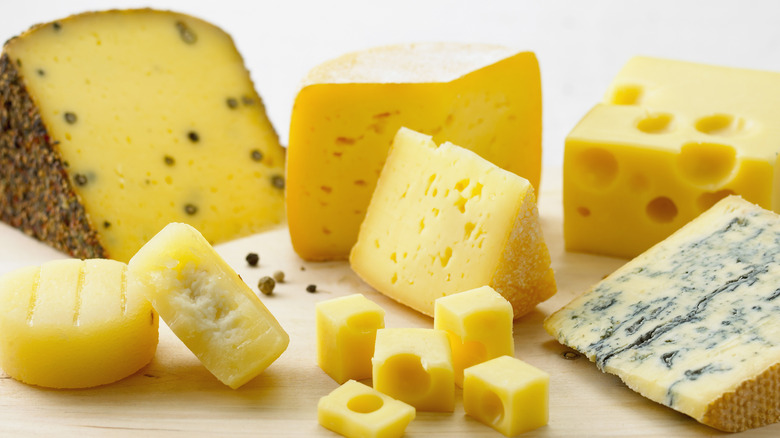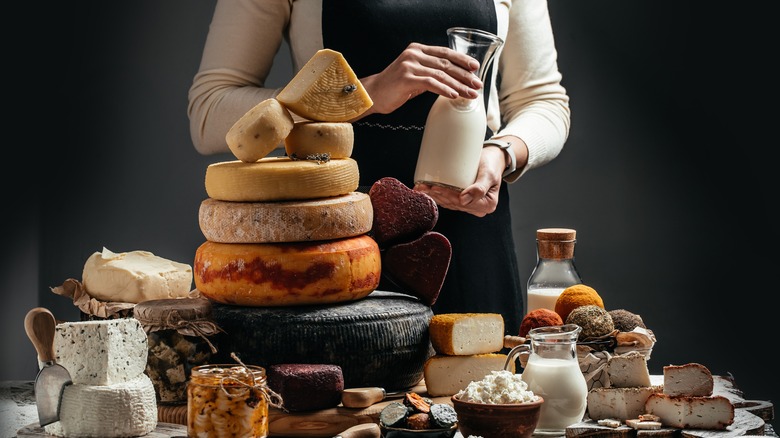Why Some Cheeses Are More Expensive Than Others, According To An Expert
It's a given that the world loves cheese, with its history tied to a panoply of international sources over at least 4,000 years. Various versions of cheese traveled and reinvented themselves across Asia, Arabia, the Roman Empire, and Europe, and even reportedly hitchhiked to America via pilgrims on the Mayflower voyage of 1620. With such widespread devotion, it's no surprise that certain cheeses command eyebrow-raising prices — but what really determines why some are more expensive than others?
To explore the intricacy of cheese values and pricing, we turned to an expert in the field: Matthew Rose, ACS, CCP, CCSE, Partner at Fairfield and Greenwich Cheese Company. As we surmised, there's a lot at play behind the scenes of American and European cheesemaking. It's both an art and a science, which tumbles into the mainstream as a commodity for daily buying and selling. Producing well-loved cheeses pretty much breaks into two categories: handmade artisanal cheesemakers and large commercial producers. Prices follow accordingly.
Handmade cheeses can be expensive, as Rose points out, "because there is no real shortcut to quality." Small-batch artisanal cheese generally involves much more hands-on care by the creators but also from partners bringing it to buyers. He explains that "the more care and attention distributors spend for logistics and transportation and that retailers give to end-stage care and handling and communication, the better the end product and experience will be" for those bringing it into their homes. It also typically means higher price points.
Large cheese producers source in volume
Larger cheese producers have some advantages when it comes to price, primarily due to large-scale production. Automated and mechanical production and operations typically equate to higher efficiency and higher volumes of cheese. Unlike smaller regional operations or artisan cheesemakers working on family-owned farms, the large commercial operators buy milk in bulk from multiple dairy farms, making it less costly but with a potential for lower quality due to things like inferior animal feed.
The pooling of milk from congregated sources also requires pasteurization to make the cheeses standardized, according to Matthew Rose. "All of these measures that are taken to insure a product that is less costly will also inherently limit its value from a sensory perspective," he notes. With all the factors together, from lower feed and milk quality, to faster-acting cultures and additives to maximize yield, "the end product will invariably suffer in terms of flavor, texture, nutritional value and ultimately, potential value."
Yes, the larger brand-name cheeses will come at more affordable prices, but they arguably lose quality and authenticity along the way. Most supermarkets have separate sections for mainstream commercial cheeses and handmade artisanal ones. You'll almost certainly see exponentially higher price tags in the devoted high-end cheese displays, which also showcase many European cheeses having the same high quality and taste as American handmade brands. But there's a significant difference in how European cheeses are produced, which explains how they're typically priced lower than their American artisanal counterparts.
European cheesemakers have more support
There's a definite disparity in the end-stage prices between imported European cheese and domestically produced ones, notes Matthew Rose, who shares some insights on why. A primary reason those heavenly high-end imported cheeses can cost less than handmade ones in America is that Europe generally subsidizes and favors small farms. The United States instead tends to prioritize large-scale farms. But economic support isn't the only thing at play in keeping prices low for European cheeses compared to their counterparts in America.
Centuries of cheesemaking give European countries a big head-start on perfecting the art. From Italian favorites such as gorgonzola, provolone, and Parmigiano-Reggiano to the pleasures of French camembert, brie, and gruyére, the cheese industry has a well-vested interest in preserving the tradition and maintaining affordability. They're more organized as an industry while remaining specialized and regionally distinct. A European quality-control system known as Protected Destination of Origin (PDO) ensures cheeses are made only in a specific area, sometimes even requiring certain elevations, milk percentages, or must graze in designated areas. For example, French Beaufort cheese must use milk from Tarine or Abondance cows grazing in the French Alps.
America has similar cultural aspirations for cheesemaking, but there's some catching up to do. Rose points out, "The American artisanal cheese industry is not that advanced yet, although we do have a taste for it enough to be a pretty important global consumer."


